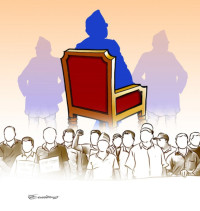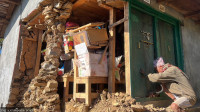Opinion
Know thy self
Oftentimes, in our quest to be globally informed, we tend to forget the local history and practices
Deepak Thapa
A few weeks ago, the Saturday edition of this paper had a cover story entitled ‘Discarding age-old taboos, more Nepalis are eating pork’. I was immediately drawn by the title, not least because the meat of the pig happens to be a favourite, but also because of the somewhat unusual subject. A quick glance indicated the piece would be informative as well. Given that the author, Thomas Heaton, had just previously written about the cuisine of eastern Nepal, one presumed that was where the inspiration came from and as much could be deduced from the strapline: ‘Celebrated by Limbus, Rais and Tharus but forbidden to Bahuns and Chhetris, pork…’
Anyone who has travelled to eastern Nepal will have noticed the strong affinity Rais and Limbus have for the pig. And, for those not of a peripatetic bent, the growing ubiquity of signs in many urban centres advertising the meat of the ‘Dharane Kalo Sungur’, the particular breed of black-haired pig popular in Dharan, would have indicated that pigs are more than favoured in that part of the country. Of course, the easterners’ regard for the pig does not go to extremes as described by the American anthropologist, Marvin Harris.
In his celebrated Cows, Pigs, Wars, and Witches, after explaining why the pig is taboo among Jews and Muslims, followers of religions that originated in the arid lands of West Asia, Harris takes the reader to the lush Pacific islands where the pig is more than just a source of protein. Describing the status of the pig in New Guinea, he writes: ‘Pig love includes raising pigs to be a member of the family, sleeping next to them, talking to them, stroking and fondling them, calling them by name, leading them on a leash to the fields, weeping when they fall sick or are injured, and feeding them with choice morsels from the family table…pig love also includes obligatory sacrificing and eating of pigs on special occasions. Because of ritual slaughter and sacred feasting, pig love provides a broader prospect for communion between man and beast…’
Considering the prominent role of pig meat in many of their rituals, the ‘communion between man and beast’ is definitely quite pronounced among the Limbus even if fondness for the pig is somewhat more circumscribed than among New Guineans. And, Heaton has managed to capture most elements of that cultural and culinary affinity rather well. What stood out starkly though was that there was not one mention of the equally intense love of the flesh of the pig among members of a group much larger than the Rais and the Limbus put together—the Magars.
Know your country
As a foreigner, Heaton can be excused for not being aware about the relationship between Magars and pigs (although for some Magar sub-groups pork is not quite kosher). What was disappointing was that no one at the editorial desk noticed such a glaring omission. Which actually points to a larger problem with most of us Nepalis. We know much more about other countries and cultures than that of our own friends, neighbours, colleagues, and, with the increasing trend of cross-ethnic/caste marriages, even families.
One can attribute this to the failure of the education system since there has hardly been anything in our school curriculum to inform us about our own country. A bit of history here, consisting mainly of a listing of kings and their deeds, a bit of geography there. Nothing about the people of Nepal, with the exception of folk tales scattered over the school year that generally ended of introducing stereotypes (even if more positive than negative nowadays) about certain groups.
The school curriculum is certainly very different from that of Panchayat times. The characters in the textbooks are much more diverse in terms of gender and social origin, but that is as far as it goes. There is not much for Nepalis of a multitude of ethnicities, religions or languages to identify with. This refusal to acknowledge this great socio-cultural diversity of our country is perhaps a hangover from the Panchayat days when only ‘Nepalis’ were acknowledged to exist as in the census results from that period. But, since a proper education system did not exist prior to the late 1950s, a counterfactual cannot even be offered.
As a result, we have seen generations of educated people with scarcely an idea about most other Nepalis;of their hopes, aspirations and fears; the value systems guiding them; or even what citizenship of this country means to them. Hence, one finds the egregiously uninformed shaping public understanding of any number of issues. Take, for instance, the public discussion on the scourge of the system of rotating credit that has afflicted Nepali society in recent years and led to the ruination of many families. The entire Nepali media has taken to calling this form of self-help enterprise, dhukuti, the Nepali term for where a family’s valuables and money are stored.
I have yet to come across any article that uses its actual name, dhikuri. The institution of dhikuri originated in the Mustang Valley among the Thakalis and their northern neighbours. Following Donald Messershmidt, anthropologist Ram Bahadur Chhetri writes that dhikuri is probably derived from the Tibetan words ‘dhu’ for wheat, and ‘kor’ for rotate or circumambulate. Forms of rotating credit is commonly found in many parts of the world, in circumstances, according to anthropologist Clifford Geertz, where transformation is taking place ‘from a traditionally agrarian society to an increasingly fluid commercial one’, just the kind of situation the traders of Mustang would have found themselves in during the salt trade. Instead of digging around, the media fraternity lazily assumed it had something to do with dhukuti, and began calling it thus. There is even a Wikipedia entry with the same misinformation. Consequently, one finds calls now and then to outlaw dhikuri (or, rather, dhukuti?)without any realisation that it is a practice that has been an integral part of the economic life of a number of groups for a long time.
Wholesome education
Under the new federal structure in place and with basic and secondary education having made the preserve of local governments, there is now an opportunity to redress all these decades of neglect. At the very least, priority should be given to localised textbooks to educate children about the places around them and the peoples they share these with. In fact, local governments could go one better and introduce at the lower levels a third language apart from Nepali and English, one that is spoken predominantly by the local communities. This would have the benefit of providing education to children from non-Nepali-speaking groups in their respective mother tongues with all its advantages while also developing empathy for the language and the culture it embodies among their classmates who speak other languages. It will take a lot of time, resources, and, above all, commitment to take this path. The outcome of a more enlightened citizenry will definitely make it worth it




 9.12°C Kathmandu
9.12°C Kathmandu










